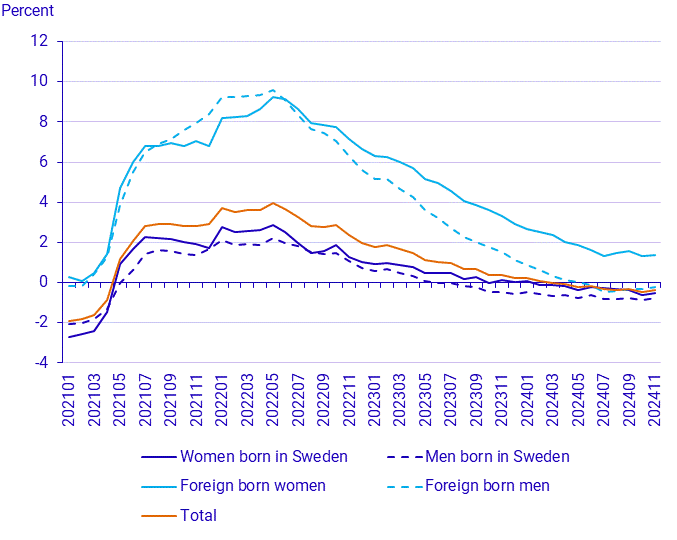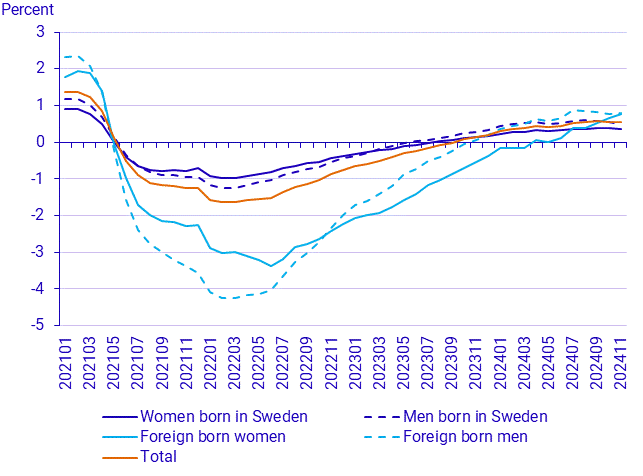Population by Labour market status, November 2024
Continued decrease in employment and rising unemployment in November 2024
Statistical news from Statistics Sweden 2025-01-31 8.00
People in employment aged 15 to 74 numbered 5 160 000 in November in 2024. This is a decrease of 20 000 people compared with November 2023. In the 20 to 65 age range, 286 000 people were unemployed. This equals a share of 5.6 percent expressed as a percentage of the labour force and is an increase of 0.6 percentage point compared with the same period of the previous year.
People in employment
The number of people in employment aged 15 to 74 decreased in November by 0.4 percent compared to the same period the previous year, but the trend varies depending on sex and region of birth.

The unemployed
The number of unemployed people aged 20 to 65 in November was 286 000, which is an increase of 29 000 compared to the same period the previous year.
The relative unemployment rate - the proportion of unemployed people in relation to the labour force - was 5.6 percent for women and 5.7 percent for men. This equals an increased unemployment rate among woman of 0.5 percentage point, and 0.6 percentage point among men compared with the same period of 2023.
Unemployment is higher among foreign born people than among those born in Sweden. In November the unemployment rate was, among foreign born people 12.5 percent and among people born in Sweden 3.3 percent.

| November 2024 |
October 2024 |
November 2023 |
Change since November 2023 (%) |
|
|---|---|---|---|---|
| Employed | 5 160 000 | 5 166 000 | 5 180 000 | ‑0.4 |
| Women | 2 512 000 | 2 516 000 | 2 514 000 | ‑0.1 |
| born in Sweden | 1 954 000 | 1 957 000 | 1 964 000 | ‑0.5 |
| foreign born | 558 000 | 559 000 | 550 000 | 1.4 |
| Men | 2 648 000 | 2 650 000 | 2 665 000 | ‑0.6 |
| born in Sweden | 2 035 000 | 2 036 000 | 2 051 000 | ‑0.8 |
| foreign born | 613 000 | 614 000 | 614 000 | ‑0.2 |
| November 2024 |
October 2024 |
November 2023 |
Change since November 2023 (%) |
|
|---|---|---|---|---|
| Employed | 4 796 000 | 4 809 000 | 4 816 000 | ‑0.4 |
| Women | 2 333 000 | 2 339 000 | 2 335 000 | ‑0.1 |
| Men | 2 464 000 | 2 470 000 | 2 480 000 | ‑0.7 |
| Employment rate (%) | 78.7 | 79.0 | 79.3 | ‑0.5 |
| Women | 78.2 | 78.5 | 78.7 | ‑0.5 |
| born in Sweden | 83.0 | 83.2 | 83.4 | ‑0.4 |
| foreign born | 65.6 | 65.9 | 66.1 | ‑0.5 |
| Men | 79.2 | 79.4 | 79.8 | ‑0.6 |
| born in Sweden | 82.6 | 82.8 | 83.2 | ‑0.6 |
| foreign born | 70.0 | 70.2 | 70.6 | ‑0.6 |
| Unemployment | 286 000 | 282 000 | 257 000 | 11.2 |
| Women | 137 000 | 136 000 | 124 000 | 10.8 |
| born in Sweden | 52 000 | 51 000 | 45 000 | 14.9 |
| foreign born | 86 000 | 85 000 | 79 000 | 8.4 |
| Men | 148 000 | 146 000 | 133 000 | 11.6 |
| born in Sweden | 73 000 | 72 000 | 63 000 | 15.4 |
| foreign born | 75 000 | 74 000 | 69 000 | 8.1 |
| Relative unemployment rate (%) | 5.6 | 5.5 | 5.1 | 0.6 |
| Women | 5.6 | 5.5 | 5.0 | 0.5 |
| born in Sweden | 2.8 | 2.8 | 2.4 | 0.4 |
| foreign born | 13.8 | 13.7 | 13.0 | 0.8 |
| Men | 5.7 | 5.6 | 5.1 | 0.6 |
| born in Sweden | 3.7 | 3.7 | 3.2 | 0.5 |
| foreign born | 11.3 | 11.2 | 10.5 | 0.8 |
| November 2024 |
October 2024 |
November 2023 |
Change since November 2023 (%) |
|
|---|---|---|---|---|
| Students | 198 000 | 186 000 | 188 000 | 5.3 |
| Women | 113 000 | 106 000 | 108 000 | 5.0 |
| Men | 85 000 | 80 000 | 81 000 | 5.7 |
| Retirees | 76 000 | 76 000 | 85 000 | ‑11.0 |
| Women | 37 000 | 38 000 | 43 000 | ‑12.1 |
| Men | 38 000 | 38 000 | 42 000 | ‑9.8 |
| Sick | 229 000 | 229 000 | 227 000 | 1.0 |
| Women | 126 000 | 126 000 | 125 000 | 0.7 |
| Men | 103 000 | 103 000 | 102 000 | 1.4 |
| Others | 507 000 | 508 000 | 502 000 | 1.0 |
| Women | 235 000 | 236 000 | 232 000 | 1.2 |
| Men | 272 000 | 272 000 | 270 000 | 0.8 |
Definitions and explanations
BAS, Population by Labour market status, presents statistics based on administrative data concerning aspects such as number of people in employment, unemployed people, and people outside the labour force for the registered population aged 15 to 74. The statistics can be used to describe current status, but also the progression over time. It illuminates both the entire population and smaller groups, such as detailed age groups at the municipal level.
The statistics contain estimates of the number of people broken down by labour market status: Employed, unemployed, student, retiree, sick and others. The definition of labour market status is hierarchical, which means that a person can only be assigned one labour market status, and it is determined according to the order of precedence above.
The labour force consists of employed people and the unemployed.
The labour market status categories that are outside the labour force are student, retiree, sick and others. There are fewer people outside the labour force in the summer than during other parts of the year. This is mainly because some people who are students during term time work during the summer and are then classified as employed.
Feel free to use the facts from this statistical news but remember to state Source: Statistics Sweden.
